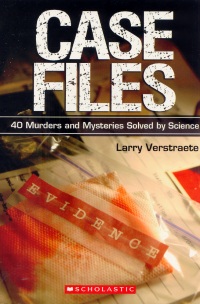| ________________
CM . . . . Volume XVIII Number 10 . . . . November 4, 2011
excerpt:
Larry Verstraete's newest book contains 40 stories about "perplexing cases that have been solved with the help of scientists." Historical mysteries, such as "The Case of the Lost Romanovs" and "The Case of the Pharaoh's Suspicious Death," are combined with more recent mysteries, such as "The Case of the Killer Flu" (1993) and "The Case of Columbia's Final Flight" (2003). Verstraete has skillfully explored these diverse topics by describing how science helped to solve these mysteries. Case Files is organized under four different purposes of scientific detection - identify, prove, explain and resolve. In the "identify" section, the stories revolve around answering the basic question, "Who/what is this?" Here we find stories of skeletons wrapped in carpets, missing pirate ships, mysterious and deadly diseases, and missing Russian royalty. There are many types of scientists involved in solving these mysteries. In "The Disturbing Case of the Skeleton in the Carpet," entomologists (experts on insects) discover the true identity of the skeleton. In the following three chapters, various other types of scientist help solve the mysteries. In the "prove" section, the basic question is, "What proof can help solve the mystery?" Forensic geologists (experts on soil deposits) help reveal the murderer of eight-year old Rajesh Gupta by examining an oily stain on his clothing. In the "explain" section, the basic question is, "What is the explanation?" Forensic anthropologists (experts in bones) help identify two skeletons found outside Avion, France, in 2003. They turn out to be the remains of Canadian soldiers who fought in the First World War. And finally, in the "resolve" section, the basic question is, "How can this controversy be resolved?" Radiologists using CT scans of the mummified body of Tutankhamun determine that the young king died of natural causes and was not murdered. Larry Verstraete combines his training as a science teacher with his talent for research. Many of his books explore his scientific interests – The Serendipity Effect (1989), Whose Bright Idea Was It? (1997), and Extreme Science: Science in the Danger Zone (2000). In a 2009 CM Profile, Verstraete discusses the power of nonfiction to capture the imagination of even reluctant male readers: "Some can't slog their way through a novel and won't accept a novel with a female protagonist, but they will chart their way through material that they find fascinating on a subject that's interesting to them. Even if they hit the most technical terms, they will still persist." The obvious media connections to television crime shows where forensic investigators solve complex mysteries will also appeal to younger and mature readers alike. Although the stories in Case Files: 40 Murders and Mysteries Solved by Science are interesting and thought-provoking, the black and white illustrations are grainy and could use some greater graphic detail to enhance their effectiveness. As well, the inclusion of a list of sources and websites would provide eager readers with starting points to further explore the stories. In Case Files, readers can read individual stories at their leisure. There is no need to address the mysteries in order. However, the fast-paced stories are so full of dramatic events and historical information that readers will be hard pressed not to eagerly read the book from start to finish! Highly Recommended. Myra Junyk, a literacy advocate and author, resides in Toronto, ON.
To comment
on this title or this review, send mail to cm@umanitoba.ca.
Copyright © the Manitoba Library Association. Reproduction for personal
use is permitted only if this copyright notice is maintained. Any
other reproduction is prohibited without permission.
NEXT REVIEW |
TABLE OF CONTENTS FOR THIS ISSUE
- November 4, 2011.
AUTHORS |
TITLES |
MEDIA REVIEWS |
PROFILES |
BACK ISSUES |
SEARCH |
CMARCHIVE |
HOME |
